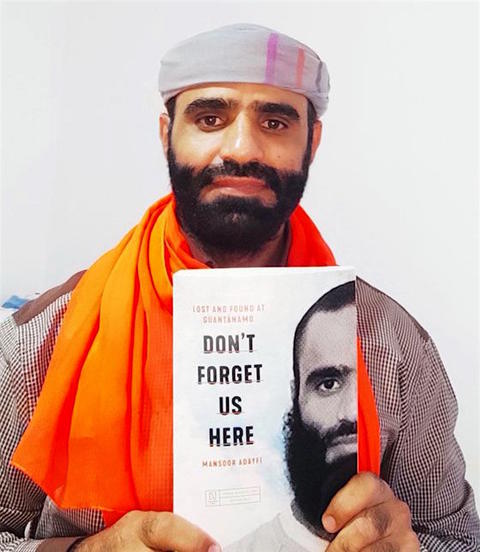Mansoor Adayfi’s “Don’t Forget Us Here”: A Devastating Account of Guantánamo’s Cruelty, But One Suffused with Hope, Humor and Humanity

Mansoor Adayfi and his memoir, "Don't Forget Us Here: Lost and Found at Guantánamo," published today.
By Andy Worthington, August 17, 2021
Imagine being seized in Afghanistan or Pakistan, being brutalized in U.S. prisons in Afghanistan, and then being sent halfway around the world to Guantánamo, a U.S. naval base in Cuba, where you are then imprisoned indefinitely, without charge or trial, in a prison facility that was specifically chosen to be beyond the reach of the U.S. courts, and where all of the normal rules regarding the detention and treatment of prisoners no longer applied.
Imagine being held, for years, on and off, in solitary confinement, able only to communicate with the person in the cell next to you by lying down on the floor of your cell and shouting through small holes in the cell wall.
Imagine being punished with sometimes bone-breaking physical violence for refusing to cooperate, or for being perceived to have infringed an ever-changing set of rules designed to dehumanize you on a permanent basis, and to "soften you up" for relentless and often violent interrogations.
And imagine being taken, at all times of the day or night, to these pointless interrogations, where those questioning you, and sometimes assaulting you, are convinced that you’re a terrorist leader, that you knew about the 9/11 attacks in advance, that you knew Osama bin Laden, or that you know the whereabouts of bin Laden or the Taliban leader Mullah Omar, as a result of assessments based on unreliable testimony extracted from your fellow prisoners, or even uttered by yourself when you could no longer cope with the punishment that ensued when you failed to tell your captors what they wanted to hear.
How would you react? Would you be compliant, or would you resist?
Some prisoners, understandably, took the former route, but compliance was no guarantee of safety, as the interrogators would still demand that you provided them with useful intelligence, even if you didn’t have any.
Mansoor Adayfi, a Yemeni who was just 19 years old when he arrived at Guantánamo in February 2002, a month after the prison opened, chose the latter route — resistance — and paid a hefty price for it, both psychologically and physically, as he explains in his astonishingly powerful memoir, "Don't Forget Us Here: Lost and Found at Guantánamo," which is published today.
And while Mansoor draws on his own experiences to tell his story, he makes it clear, in his preface, that, as he describes it, "I never set out to write a book about myself. I instead wanted to tell the story of Guantánamo and of all the men who were imprisoned there" — "men from all over the world, representing fifty nationalities and speaking more than twenty languages," who were "doctors, journalists, singers, professors, students, teachers, paramedics, poets, blacksmiths, former CIA spies and assassins, farmers, tribal elders, and so much more."
As Mansoor also explains, he wanted "To show the world what life was really like. To show the world who was really there. I thought that if I could capture all the small moments of joy and beauty, of friendship and brotherhood, of hardship and the struggle to survive — all the moments that united and bonded us — that I could maybe change the way people thought about Guantánamo."
Many of these individuals — like Omar, a one-legged Libyan, who tempers Mansoor’s exuberant resistance with the voice of experience, or Zakaria, the gentle Yemeni seized in Georgia, who, sadly, is still held — make appearances throughout Mansoor’s memoir, although the main focus, inevitably, is on those who were his partners in resistance; mainly other young Yemenis, who, as men still in their teens or in their early twenties, had the energy and single-mindedness of youth to sustain them in their implacable resistance to the implacable violence and injustice of their captors, via hunger strikes, for example, and through persistent disobedience.
Mansoor tells us at one point that, in total, "There were around seventy Redeyes in the camp," as the resisters were known, but there were just eleven in his particular group — and it is particularly sobering to realize, as Mansoor’s narrative progresses, that five of these men died at Guantánamo; all by suicide, according to the U.S. authorities, although all of those conclusions have been robustly challenged over the years.
If all of the above sounds unbearably bleak, in one way it is, as Mansoor truthfully chronicles the depths of depravity of the regime at Guantánamo, and yet he is so fundamentally full of hope, humanity and extraordinary humor that the darkness is persistently punctuated by sharp and surreal observations, by charming tales of camaraderie and of pranks played on the guards and even the prison’s commanders, as well as moments of buoyancy snatched from the jaws of despair.
Not for nothing was Mansoor known to the prison authorities as "Smiley Troublemaker," a name that perfectly captures the fearless charm of his resistance.
Fortunately, in 2009, Mansoor’s story suddenly changed, when he was, for the first time, assigned an attorney — Andy Hart, a federal public defender from Ohio, whose arrival helped him to see beyond the endless struggle with the authorities that had consumed him for seven years.
It was at this time that he began writing down stories from Guantánamo, and sending them to Andy — stories that, along with other stories he sent to his new attorney, Beth Jacob, after Andy’s untimely death — became the basis of "Don’t Forget Us Here," on which Mansoor worked closely with the writer and editor Antonio Aiello.
In addition, at this time, Omar, the Libyan, negotiated the conversion of one block, Camp 6, into a communal block if Mansoor and his friends brought to an end their latest hunger strike, and they all then moved into the block, where Mansoor met another mentor, Saifullah Paracha, Guantánamo’s oldest prisoner, who is still held (and who he wrote about for us in 2018), and where, wonderfully, the prison authorities then allowed the prisoners to express themselves through art — a brief period of extraordinary creativity, in which prisoners like Moath al-Alwi, also still held, sadly, became adept at making detailed sailing ships, complete with masts and sails, from nothing more than discarded materials.
This period of tolerance and creativity didn’t last, of course, but eventually Mansoor was released, after a review process set up under President Obama, the Periodic Review Boards, concluded that it was safe to release him — after all those long and pointless years when the U.S. authorities believed that he was someone significant in terrorist circles, and not just a student seized by mistake, who then refused to accept the thorough and comprehensive injustice of the whole malign Guantánamo experiment.
Mansoor was finally sent to live in Serbia in 2016, because the entire U.S. establishment has persistently refused to allow Yemenis to be repatriated, blaming the security situation in their homeland, and while there is no denying that, in Serbia, he has had reason to revisit his habit of non-compliance, learned at Guantánamo, he has also, more particularly, blossomed into the accomplished writer whose unique and uniquely powerful memoir has been published today.
I hope you will order a copy, if you haven’t already.
Note: For further coverage, check out The Intercept’s detailed article, "'They Believed Anything But the Truth' — 14 Years in Guantánamo" by Cora Currier, an interview in the Guardian, the New York Times review, and Mansoor’s article for the Boston Globe, "I became Detainee 441. The U.S. can’t separate Afghanistan from Guantánamo." Also see an excerpt from the book in the Los Angeles Times.




